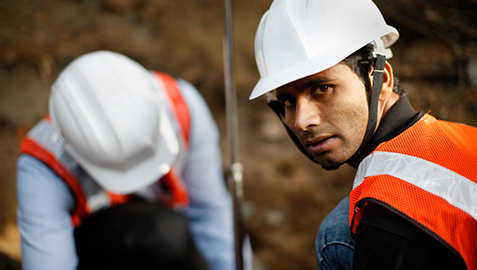Take on the challenge of continuous water distribution in the town
In January 2013, Delhi Jal Board (DJB) launched a pilot project for improving the efficiency of water distribution network under Malviya Nagar UGR Command Area. DJB awarded SUEZ this 12-year contract to improve water distribution services for 400,000 residents in the project area. Malviya Nagar Water Services (MNWS), a special purpose vehicle was launched to implement this program. The inhabitants of the district of Malviya Nagar had an unreliable and irregular supply of water. The water network efficiency was 33%, a sign that there were many leaks.
Deliverables for the 12-year project
- Safe, clean drinking water for every household
- 100% network coverage throughout the project area
- Continuous supply for consumers
- Reduction of Non-Revenue Water From 68% to 15 % by the end of the contract
- Revenue Management Improvement
- Prompt Grievance Redressal and Improvement in Service to Consumers
- Operation and maintenance of the water supply facilities in the service areas
Take comprehensive action to improve the performance of the network
“CUSTOMER FIRST” POLICY:
A very smart and efficient Customer Care System was put in place, from Day 1 of the operation, with several facilities that were probably introduced for the first time:
- A 24x7 toll-free helpline number for all types of complaint registrations for quick action
- A system showing the current status of registered complaints, shutdown and breakdown Information, call back facility to repeated calls, etc.
- Efficient meter reading and bill distribution and 100% billing for all customers
- Query resolution at the time of reading and billing, sensitization of Government Policies like free water, etc.
- An air-conditioned state-of-the-art customer contact center at Saket making the bill payment extremely convenient and easy with the help desk to assist the customers for form filling, guidance, and queries, without making them wait or stand in long queues.
INNOVATIVE TECHNOLOGY AND PROCESSES
- Helium Leak Detection Technique for invisible leaks: To minimize water loss and ensure a transition to 24/7 water supply, MNWS used Helium tracer gas technique, a globally successful and proven technique developed by SUEZ. This technique is highly effective where there are intermittent supply, low pressure and noisy environment that makes detection with traditional technique difficult and inefficient. The application needs no pre-localisation for leak finding, is highly accurate in locating the leak point and finds more leaks compared to any other technique.
- An integrated GIS for digitalization of database: The operation & maintenance of any distribution network is based on a good database of its customers. GIS is a powerful tool that effectively links data on a real-time basis and enables the user to solve problems by uncovering and analyzing trends. MNWS has pioneered in integrating mobile GIS into water distribution sector. All our supervisors and project monitoring team are geared up with latest mobile application and tablets for real time monitoring. An integrated GIS and Remote Sensing system with the construction drawings, Leak Detection, and Mapping, Consumer Survey and GIS Mapping, assets have been developed to reduce response time and increase efficiency.
- 24/7 WATER SUPPLY IN GITANJALI ENCLAVE & NAVJEEVAN VIHAR: As the first step towards improving water supply, all leakages were identified through Helium Gas leak detection technique and repaired, followed by the replacement of the house connections to address the external leakages. To optimize the network, a small network connection in the area was made to increase pressure in tail ends and increase pressure monitoring points in the area.
It was clear that developing a successful demonstration project would take not only technical skills but also significant communication and social skills. To educate the residents about the program, meetings with the Resident Welfare Association and residents were organized regularly to explain their roles in minimizing water loss in their network, overhead tanks, and reservoirs. MNWS team visited every house in the area to check the internal network and installed/ replaced meters where required.
To give the consumers an actual picture of their water consumption post continuous supply, meters were read on a weekly basis and dummy bills were distributed so that the consumers can fix the issues related to water leakage or overflow of overhead/underground tanks.
HEALTH & SAFETY – TOP PRIORITY FOR US
At MNWS, we have an excellent track record, with regular training to our employees, health and safety camps including medical checkup of employees, diet consultation, lifestyle counseling, etc.
To ensure the best quality of water in our project area, we measure the Critical parameters including turbidity, PH and residual chlorine daily basis by collecting water samples from the consumers’ premises, Malviya Nagar UGR & the entire BPS within the project area. This ensures contamination-free potable quality water in the project area.
EDUCATING AND BUILDING CAPABILITY OF COMMUNITY ON WATER CONSERVATION
In order to sensitize the communities of water conservation, MNWS regularly organizes community-focused water conservation program. These programs targeted mostly towards training women groups and introducing very small initiatives that can be practiced on a day-to-day basis which can bring long term results.
DEDICATED AND MOTIVATED TEAM
Our organization believes that employees are the primary stakeholders and respects their fundamental rights at the workplace and provide opportunities for both professional and personal development. At MNWS, International experts were hired to transfer global technical know-how and build capabilities of employees in operation and customer service functions.
The Result
- 39% increase in the number of registered connections over the last six years
- 70% increase in billed volume.
- Six times increase in revenues
- 41% reduction in Litres per Capita per Day (LPCD) due to leakage fixing (both distribution network/House Service Connection and internal network) and water conservation sensitization
- 43% decrease in non-revenue water
- Significant reduction in contamination complaints by replacing HSC with leak-proof saddle installed using fusion technique.
- Saving of electrical energy by installing energy efficient equipment such as variable frequency drive, LED lights etc.
